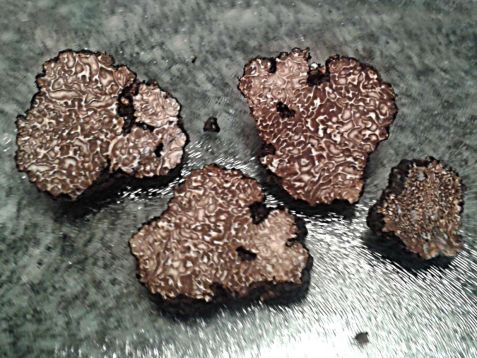MLZ is a cooperation between:
 > Technische Universität München
> Technische Universität München > Helmholtz-Zentrum Hereon
> Helmholtz-Zentrum Hereon
 > Forschungszentrum Jülich
> Forschungszentrum Jülich
MLZ is a member of:
 > LENS
> LENS > ERF-AISBL
> ERF-AISBL
MLZ on social media:

MLZ (eng)
Lichtenbergstr.1
85748 Garching
Bad times for truffle counterfeiters: Neutrons detect trace elements in popular edible mushrooms
The truffle’s fruitbody grows underground in symbiosis with tree roots of oaks or hazelnuts. Thanks to their tastiness, one kilogram of white Italian truffles is worth up to 9,000 euros. And so, the less valuable Croatian truffles are often sold as genuine Italian truffles. Until now, there was no possibility to check the origin of the truffles, which played into the hands of counterfeiters.
Dr. Matthias Rossbach and Dr. Christian Stieghorst analysed German summer truffles from 27 different locations throughout Bavaria, Lower Saxony, Thuringia, and North Rhine-Westphalia to develop a method that could trace back the truffles’ origin.
Single elements reveal the origin
For their analysis, Rossbach and Stieghorst used the Prompt Gamma Activation Analysis (PGAA) at the research neutron source of the TUM. Here, the samples are irradiated with cold neutrons. Following the neutron capture, the atomic nuclei of the chemical elements emit characteristic gamma rays. This gamma radiation in turn is detected and serves to identify the elements in the sample.
Via PGAA analysis in Garching, scientists could detect 20 different elements and could quantify their amounts in the mushrooms. “Now, we can determine the amounts of sodium, magnesium, copper, or cadmium inthe truffles with the precision of a billionth of a gram”, says Christian Stieghorst.
The data analysis revealed that arsenic, silver, hafnium, and lead shows the greatest location-dependent dispersion. Stieghorst thinks this to be a result of the different soil conditions. “Finally, we could accurately match the truffles to the different locations via a principal component analysis (PCA).”
More heavy metals in truffles from Bad Reichenhall
“The heavy metal pollution of summer truffles in Germany is astonishingly low and therefore harmless”, says Matthias Rossbach. Only one sample from Bad Reichenhall showed a lead content five times higher than all the other truffles.
Rossbach assumes that this is caused by the zinc and lead mining which took place in this area. It seems that the mushrooms accumulate the heavy metals to keep them at bay for their symbiosis partners, the trees.
As the next step, the scientists want to expand the project to other truffle species. “We do not need to analyse all elements, but only the ones, which give clues of the mushrooms’ origin”, says Rossbach. Hopefully, it will be possible to recognize falsely labelled truffles.
Further information:
Members of the Hypogea research group collected the truffles (Tuber aestivum) with the help of their specially trained dogs.
To verify and extend the results, the scientists also sent the samples to the research reactor in Warsaw, Poland. There, neutron activation analysis (INAA) and mass spectrometry with inductively coupled plasm (ICP-MS) were carried out. Both methods obtained similar results. In total, the scientists identified 43 different elements in the truffles.
MLZ is a cooperation between:
 > Technische Universität München
> Technische Universität München > Helmholtz-Zentrum Hereon
> Helmholtz-Zentrum Hereon
 > Forschungszentrum Jülich
> Forschungszentrum Jülich
MLZ is a member of:
 > LENS
> LENS > ERF-AISBL
> ERF-AISBL
MLZ on social media:




